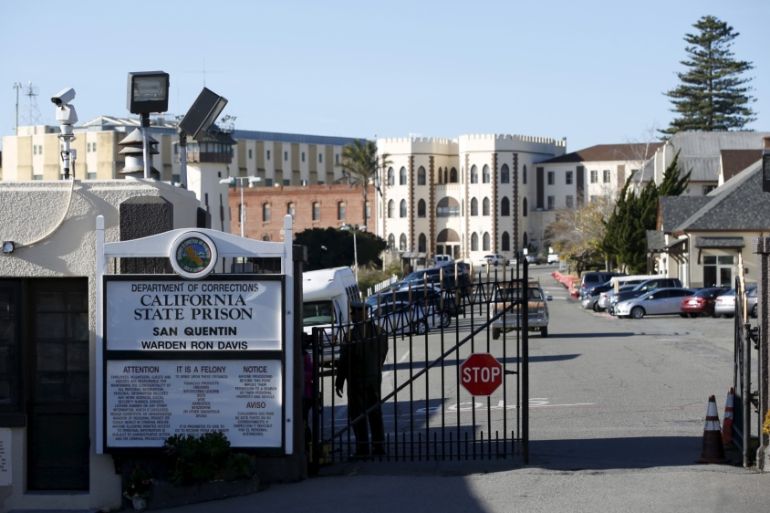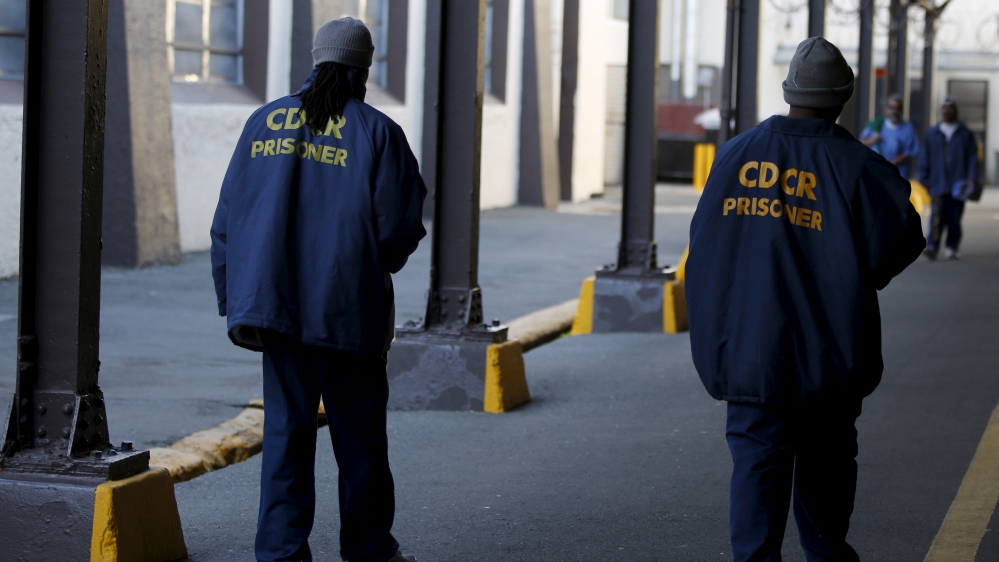COVID-19 prison problem as cases soar at California’s San Quentin
The prison’s first cases occurred in June, climbing to over 500 in one month and more than quadrupling this week.

The California state jail system has seen a staggering increase in coronavirus cases over the past week – with cases at the overcrowded San Quentin facility jumping from 100 to 539 – and total inmate deaths across the state prison system totalling 20.
Attorneys, advocates and former inmates say this increase suggests that lowering prison populations might be the only effective way to stop the pandemic’s resurgence inside the US penitentiaries.
Keep reading
list of 4 itemsMyanmar’s Aung San Suu Kyi moved to house arrest amid heatwave
‘Joyful but afraid’: Disabled Indian academic Saibaba’s family on acquittal
Gangs in Haiti break thousands of inmates out of prison
The state has seen 1,001 new COVID-19 cases in its prison system in the past 14 days, the California Department of Corrections and Rehabilitation (CDCR) said on Friday afternoon. This increase comes as the United States experiences record-setting spikes in coronavirus cases.
San Quentin is California’s only state prison with a death row, accounted for the majority, with 512 new cases as of Friday. The prison is in Marin County, near the city of San Francisco.
The outbreak at San Quentin has grown quickly. Officials said last weekend there were about 100 cases. By Monday, the total had jumped to 300, with an additional 174 cases in both inmates and staff reported by Thursday.
San Quentin is overpopulated. A June 24 population report (PDF) from the CDCR shows the prison had 3,507 inmates, or 113.8 percent of its total capacity of 3,082.
Overpopulation and poor decisions play a huge role in the outbreak, according to James King, the state campaigner for the Ella Baker Center for Human Rights who spent roughly six-and-a-half years in San Quentin, and was released in December.
Overcrowding
King noted that all of San Quentin’s cases began in June, after the May 30 transfer of 121 inmates from Chino, another California state prison that had a coronavirus outbreak.
Most of those inmates had not been tested for coronavirus before switching prisons, according to local media.
King told Al Jazeera that while this transfer was likely the cause, an outbreak “could have occurred a myriad of ways due to how people come in and out” of the facility.
The prison is separated into four housing blocks, North, East, South and West, King explained. “In North Block and West Block … each of these buildings were designed for about 400 people”, but they house “over 700 people, closer to 800 people”.
Groups of roughly 80 people at the same time queue for food. There are 20 phones and about 25 shower heads for hundreds of people in each of the blocks, according to King.
CDCR has ordered cleaning protocols for these areas, but with such large populations, King said “there’s no way” they could be effectively disinfected.
San Quentin’s public information officer did not immediately respond to Al Jazeera’s requests for comment on King’s concerns.
National ‘failure’
“Beginning July 1, CDCR will implement a community supervision program for eligible offenders who have 180 days or less to serve and a place to safely shelter during this unprecedented global pandemic,” the CDCR said in a statement emailed to Al Jazeera.
The CDCR, which said it has taken “significant action” to provide healthcare and address the outbreak, expects 80 inmates to be released from San Quentin before July 1 as part of the programme.
King said the Ella Baker Center is calling on the CDCR and California Governor Gavin Newsom to do more, including issuing reprieves to elderly inmates like 79-year-old Fred Cole, who will not be eligible for parole until 2029 but is “not a threat to anyone and hasn’t been in a long time”.
Newsom said on June 25 that he hopes to expedite the release of low-risk inmates and state courts are reviewing the cases of about 3,500 inmates in the state prison system who could be released.
There is anecdotal evidence in California that prison releases could help stave outbreaks, Jeff Chorney, a deputy public defender for Alameda County in the Bay area, told Al Jazeera.

Chorney cited the example of the Santa Rita Jail (SRJ), which suffered its COVID-19 outbreak in March at the beginning of the coronavirus pandemic in the US, drawing concern from local activists and advocates.
SRJ responded by decreasing its inmate population about 30 percent, Chorney said, from 2,497 on March 1 to 1,805 on June 25.
While a scientific study would be needed to confirm the efficacy of depopulation, “they lowered the population very dramatically and we haven’t seen a huge outbreak”, Chorney observed.
The jail has zero coronavirus cases among its inmate population, though there are 32 current cases among employees, according to public figures.
SRJ’s response came as numerous prison advocacy groups called for releases to contain the spread of the virus in detention centres across the US.
While SRJ took effective steps, most US prisons did not, according to a joint report by the American Civil Liberties Union and The Prison Policy Initiative released on Thursday.
The report graded the 50 states on their efforts. Almost all received failing grades, including California and New York, which received “F+” rankings.
“In some states, we observed significant jail population reductions. Yet no state had close to adequate prison population reductions,” the report said.
“As of June 22, 2020, over 570 incarcerated people and over 50 correctional staff have died and most of the largest coronavirus outbreaks are in correctional facilities,” it continued.
‘More people will die’
CDCR’s latest coronavirus death was announced on June 23 and occurred at the Avenal State Prison, where there are 64 inmates with coronavirus, according to the department.
An inmate on San Quentin’s death row, 71-year-old Richard Eugene Stitely, was found dead in his cell on Wednesday night. Authorities have not released a cause of death.
|
|
The 20 confirmed COVID-19 prisoner deaths are more than the 13 people California has executed since 1976, according to the Death Penalty Information Center, a US-based organisation that tracks capital punishment.
Governor Newsom signed an order pausing executions in 2019, saying that “intentional killing of another person is wrong and as Governor, I will not oversee the execution of any individual”.
The order served as a reprieve for the 737 people on California’s death row, which was the largest number facing execution in the US.
For Alameda County Chief Public Defender Brendon Woods, prison overcrowding could be a death sentence.
“More people are going to die unless the governor acts now. The only way to stop the spread is to lower the prison population,” Woods said in a statement delivered to Al Jazeera.